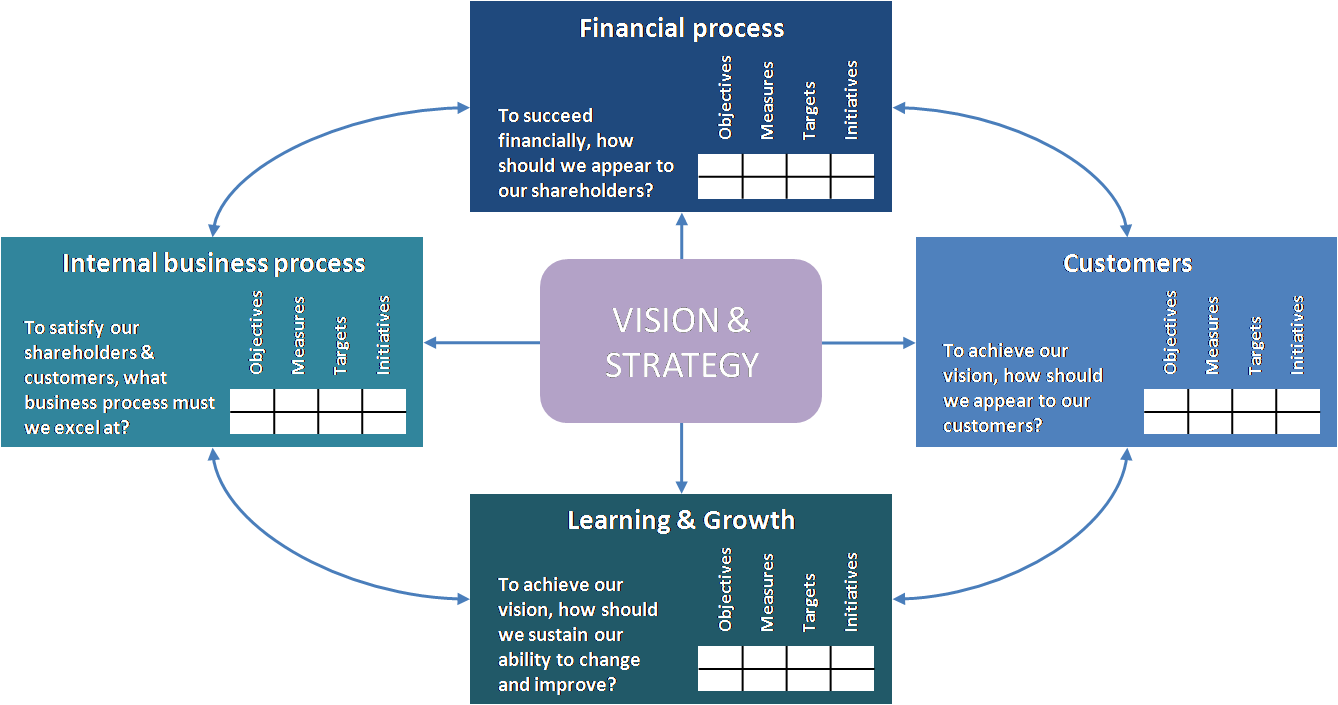Balanced Scorecard and Information Technology
Balanced Scorecard Basics
The balanced scorecard is a strategic planning and management system that is used extensively in business and industry, government, and nonprofit organizations worldwide to align business activities to the vision and strategy of the organization, improve internal and external communications, and monitor organization performance against strategic goals. It was originated by Drs. Robert Kaplan (Harvard Business School) and David Norton as aperformance measurement framework that added strategic non-financial performance measures to traditional financial metrics to give managers and executives a more 'balanced' view of organizational performance. While the phrase balanced scorecard was coined in the early 1990s, the roots of the this type of approach are deep, and include the pioneering work of General Electric on performance measurement reporting in the 1950’s and the work of French process engineers (who created the Tableau de Bord – literally, a "dashboard" of performance measures) in the early part of the 20th century.
Gartner Group suggests that over 50% of large US firms have adopted the BSC. More than half of major companies in the US, Europe and Asia are using balanced scorecard approaches, with use growing in those areas as well as in the Middle East and Africa. A recent global study by Bain & Co listed balanced scorecard fifth on its top ten most widely used management tools around the world, a list that includes closely-related strategic planning at number one. Balanced scorecard has also been selected by the editors of Harvard Business Review as one of the most influential business ideas of the past 75 years.
The balanced scorecard has evolved from its early use as a simple performance measurement framework to a full strategic planning and management system. The “new” balanced scorecard transforms an organization’s strategic plan from an attractive but passive document into the "marching orders" for the organization on a daily basis. It provides a framework that not only provides performance measurements, but helps planners identify what should be done and measured. It enables executives to truly execute their strategies.
This new approach to strategic management was first detailed in a series of articles and books by Drs. Kaplan and Norton. Recognizing some of the weaknesses and vagueness of previous management approaches, the balanced scorecard approach provides a clear prescription as to what companies should measure in order to 'balance' the financial perspective. The balanced scorecard is a management system (not only a measurement system) that enables organizations to clarify their vision and strategy and translate them into action. It provides feedback around both the internal business processes and external outcomes in order to continuously improve strategic performance and results. When fully deployed, the balanced scorecard transforms strategic planning from an academic exercise into the nerve center of an enterprise.
Kaplan and Norton describe the innovation of the balanced scorecard as follows:
"The balanced scorecard retains traditional financial measures. But financial measures tell the story of past events, an adequate story for industrial age companies for which investments in long-term capabilities and customer relationships were not critical for success. These financial measures are inadequate, however, for guiding and evaluating the journey that information age companies must make to create future value through investment in customers, suppliers, employees, processes, technology, and innovation."
Gartner Group suggests that over 50% of large US firms have adopted the BSC. More than half of major companies in the US, Europe and Asia are using balanced scorecard approaches, with use growing in those areas as well as in the Middle East and Africa. A recent global study by Bain & Co listed balanced scorecard fifth on its top ten most widely used management tools around the world, a list that includes closely-related strategic planning at number one. Balanced scorecard has also been selected by the editors of Harvard Business Review as one of the most influential business ideas of the past 75 years.
The balanced scorecard has evolved from its early use as a simple performance measurement framework to a full strategic planning and management system. The “new” balanced scorecard transforms an organization’s strategic plan from an attractive but passive document into the "marching orders" for the organization on a daily basis. It provides a framework that not only provides performance measurements, but helps planners identify what should be done and measured. It enables executives to truly execute their strategies.
This new approach to strategic management was first detailed in a series of articles and books by Drs. Kaplan and Norton. Recognizing some of the weaknesses and vagueness of previous management approaches, the balanced scorecard approach provides a clear prescription as to what companies should measure in order to 'balance' the financial perspective. The balanced scorecard is a management system (not only a measurement system) that enables organizations to clarify their vision and strategy and translate them into action. It provides feedback around both the internal business processes and external outcomes in order to continuously improve strategic performance and results. When fully deployed, the balanced scorecard transforms strategic planning from an academic exercise into the nerve center of an enterprise.
Kaplan and Norton describe the innovation of the balanced scorecard as follows:
"The balanced scorecard retains traditional financial measures. But financial measures tell the story of past events, an adequate story for industrial age companies for which investments in long-term capabilities and customer relationships were not critical for success. These financial measures are inadequate, however, for guiding and evaluating the journey that information age companies must make to create future value through investment in customers, suppliers, employees, processes, technology, and innovation."
Please contact one of our Engineers to explore how Balanced Score Card can help integrate business strategy and IT deployment.
References:
1.0 Dreailed Article of Balanced Score Card
2.0 The Balanced Scorecard: Translating Strategy into Action- ISBN 978-0875846514
